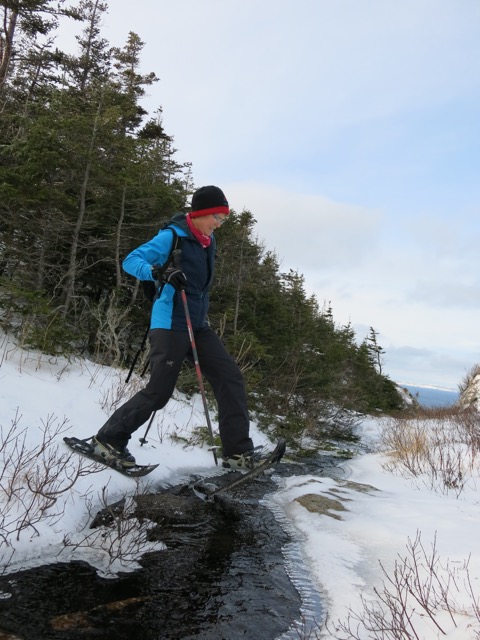The East Coast Trail can be enjoyed in all seasons but winter can be especially magical with the interaction of snow, ice, and water. In order to enjoy your time on the trail in winter to the fullest, here are a few hints:
1) Pack your ten essentials in your back pack. Be sure to have a map and compass, fire starting supplies, water, snacks, extra clothes, head lamp or flashlight, sun protection, rain gear, first aid supplies and emergency shelter.
2) Start with a trail you are familiar with since the terrain and way-finding can be different in winter. The East Coast Trail is signed very well and you can often see a dip in the snow over the actual trail so it’s normally not to difficult to keep yourself on the trail but just in case, build your confidence on a trail that you’ve already hiked in winter. Bring the trail map and follow along as you hike, keeping your thumb on the map as a marker.
3) Dress in layers so you can adjust your temperature to avoid sweating and making your clothing damp. As you start hiking and warm up, take off a layer or two so that you’re, as Goldilocks would say, “Not too cold and not too hot.” When you stop for a break or to enjoy the view for longer than a minute or two, put your layers back on to capture the heat you’ve generated while hiking.
4) Keep breaks shorter in winter than in summer so that you don’t chill down too much. Bundle up the minute you stop hiking to stay warm and then shed the layers again as you start hiking after your break. Take breaks in sheltered locations out of the wind. Wind causes convective heat loss and can chill you quickly. Bring something to sit on or sit on your backpack to keep from losing heat to the snow. This is conductive heat loss.
5) Keep your energy up by snacking often. Winter hiking uses more energy that summer because not only is your body propelling you forward, it needs energy to help keep you warm.
6) If your feet are cold, put on a hat. Your head can radiate a lot of heat so capturing that heat can make your feet feel warmer. Really it can! That is called radiative heat loss and hat and gloves and clothing layers help keep that layer of heat next to us. By dressing in layers and removing them when we get warm from activity, we prevent evaporative heat loss (or loss by sweating). This is your body’s main way of cooling down so ideally you hike and dress in such a way that you keep your temperature nicely even. You can also bring a dry pair of socks to change into at the halfway mark of your hike. Wet socks mean cold feet.
7) Ice is slippery. Yes, really! Traction equipped snowshoes or hiking boots are a must in the winter. They can keep you from slipping if the trail gets icy or if you have to go down a steep descent. Mind the ice near the edges of streams when you step over. It’s thinnest there. Don’t venture out onto any pond ice unless you’ve had training in ice safety.
8) Always have a “float plan.” Tell someone you that you are heading out and when you expect to be back. Carry a head lamp or flashlight because with reduced daylight, it’s easier to be benighted in the winter.
9) Bring a thermos of something hot to drink or bring a stove to have a boil-up. Nothing makes your feel happier to be outside that a mug-up. Know how to light a fire so you can use one to keep warm if you get caught out.
10) Keep your camera and other electronics tucked into an inner pocket. Nothing zaps battery life like the cold. You’ll want to capture all that winter magic so keep your camera battery warm. Your phone is an important communications tool so protect it from moisture and keep it warm as well.










Pingback: Western Newfoundland’s Top 10 Winter Adventures – Outdoors & On the Go
Thanks for this. Please suggest short hikes for those of us healing from illness, who need to start at a very minimal level.